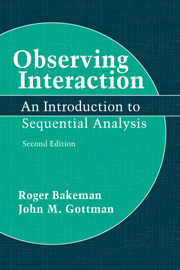Book contents
- Frontmatter
- Contents
- Preface to the second edition
- Preface to the first edition
- 1 Introduction
- 2 Developing a coding scheme
- 3 Recording behavioral sequences
- 4 Assessing observer agreement
- 5 Representing observational data
- 6 Analyzing sequential data: First steps
- 7 Analyzing event sequences
- 8 Issues in sequential analysis
- 9 Analyzing time sequences
- 10 Analyzing cross-classified events
- 11 Epilogue
- Appendix: A Pascal program to compute kappa and weighted kappa
- References
- Index
10 - Analyzing cross-classified events
Published online by Cambridge University Press: 13 October 2009
- Frontmatter
- Contents
- Preface to the second edition
- Preface to the first edition
- 1 Introduction
- 2 Developing a coding scheme
- 3 Recording behavioral sequences
- 4 Assessing observer agreement
- 5 Representing observational data
- 6 Analyzing sequential data: First steps
- 7 Analyzing event sequences
- 8 Issues in sequential analysis
- 9 Analyzing time sequences
- 10 Analyzing cross-classified events
- 11 Epilogue
- Appendix: A Pascal program to compute kappa and weighted kappa
- References
- Index
Summary
Describing cross-classified events
Earlier, in chapter 3, we distinguished between continuous and intermittent recording strategies, nothing that because this is a book about sequential analysis, we would emphasize continuous approaches. Four of these strategies (coding events, recording onset and offset times, timing pattern changes, coding intervals) are continuous both in the sense that observers are continuously alert, ready to record whenever required, and in the sense that the data recorded reflect a continuous record of some aspect of the passing stream of behavior. Such data are typically represented as event, state, timed-event, or interval sequences (see chapter 5). We also mentioned a fifth strategy (cross-classifying events), which is continuous only in the sense that observers are continuously alert, ready to record information about certain events whenever they occur. This strategy results in sequential data only if the information coded represents logically sequential aspects of the event.
This is an appealing strategy for a number of reasons. When an investigator knows beforehand that a particular kind of event is of interest, this approach provides focused information about that event with little extraneous detail. Moreover, the data can be represented and analyzed in simple, well-known, and quite straightforward ways.
As an example, let us again use the Bakeman and Brownlee (1982) study of object struggles, referred to earlier. The event of interest, of course, was an object conflict or, to put it in more neutral terms, a “possession episode.” As they defined it, a possession episode required that one child (the taker) touch and attempt to take away an object currently being held by another child (the holder).
- Type
- Chapter
- Information
- Observing InteractionAn Introduction to Sequential Analysis, pp. 177 - 183Publisher: Cambridge University PressPrint publication year: 1997



